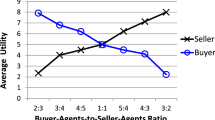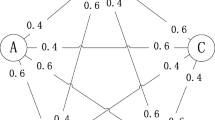Abstract
Whereas there are group strategyproof mechanisms for a variety of problems, to date, group strategyproof bargaining has not been studied. Although shill bidding is widely studied in auctions, there is currently no work that analyzes the effect of shills on bargaining mechanisms. This paper validates that Sim’s agent-based fog bargaining (AFB) mechanism is both 1) strongly group strategyproof (i.e., it is more robust than existing group strategyproof mechanisms) and 2) shill resistant. Since Internet-based agents can coordinate themselves to shade (respectively, mark up) resource prices, bargaining mechanisms that are resistant to coordinated price shading (respectively, markup) by coalitions of agents are crucial in price bargaining between fog node owners and Internet-connected device owners. Mathematical proofs validate that the AFB mechanism is strongly group strategyproof because on top of satisfying the commonly adopted condition of group strategyproofness, i.e., coordinated price shading (respectively, markup) by coalitions of agents that results in the strict gain of some agent will also result in the strict loss of another agent, it also satisfies two additional stronger conditions that 1) there is no collusive surplus from coordinated price shading (respectively, markup) and 2) every agent cannot increase his/her utility by joining a coalition. Given the ease for agents to fake identities in the Internet, shill resistance is another critically important property of fog bargaining mechanisms. Mathematical evidence validates that coordinated price shading (respectively, markup) by coalitions with shills is not feasible in the AFB mechanism.

Similar content being viewed by others
Availability of Data and Material
Data sharing is not applicable to this article as no datasets were generated or analyzed during the current study.
Code Availability
Not applicable.
Notes
A fog resource market is a periodic market for trading a perishable good because 1) it is formed at a certain period when buyers and sellers are brought together through a fog resource discovery and resource selection process and 2) fog computing resources are perishable in the sense that “computing capacity not used now is worthless in the next moment” [29, page 246], [7, page 21].
In each cycle of resource allocation activities, the set of opponents that every market participant is willing to engage in bargaining is selected after the resource discovery and resource selection process such that in the resource pricing stage, all buyers and all sellers who agree to engage in bargaining enter a fog resource market when it is formed. Other buyers and sellers who have not been selected have to wait until the next cycle of fog resource allocation activities.
The STDMC protocol is designed for bargaining between software agents which operate at machine speed. As noted in Sim [34], in the STDMC protocol, the time interval between two consecutive bargaining rounds is extremely short since contemporary computers have clock speed of several billion clock cycles per second with each cycle lasting only one-billionth of a second. Hence, the probability of breakdown between two consecutive offers owing to exogenous intervention by a third party is negligible.
McAfee, Williams, and Hendricks [16, page 502] used the term “collusive surplus” to refer to the gains from trade captured by a group of collusive agents (e.g., the gain captured by a coalition of buyers through the coordinated price shading of its members).
Even though each buyer (respectively, seller) may learn about the identities of some other buyers (respectively, sellers) through personal acquaintances, the STDMC protocol prevents each buyer (respectively, seller) from knowing the identities of all other buyers (respectively, sellers) because every buyer (respectively, seller) only interacts directly with those sellers (respectively, buyers) that they are negotiating with by sending sealed price proposals.
This work considers the gain and loss of expected utilities of agents when analyzing group strategyproofness because the iterative elimination of non-viable options by each agent leads to the probabilistic setting where two possible states can result from the coordinated price shading or coordinated price markup by members of each coalition. See the proof of Theorem 1 for details.
Since price proposals from both \({B}_{C\alpha }\in {C}\!_{B}\) and \({B}_{O\alpha }\notin {C}\!_{B}\) are arbitrary positive real numbers, there is always a chance that \({S}_{\beta }\) will reach an agreement with either \({B}_{C\alpha }\) or \({B}_{O\alpha }\). Hence, it is not absolutely impossible that \({S}_{\beta }\) will reach an agreement with \({B}_{C\alpha }\) (i.e., \({P}_{agr}^{C\alpha \leftrightarrow \beta }\ne 0\)) and it is not absolutely certain that \({S}_{\beta }\) will reach an agreement with \({B}_{C\alpha }\) (i.e., \({P}_{agr}^{C\alpha \leftrightarrow \beta }\ne 1\)).
References
Barberà S, Berga D, Moreno B (2016) Group strategy-proofness in private good economies. Am Econ Rev 106(4):1073–1099
Barberà S, Berga D, Moreno B (2010) Individual versus group strategy-proofness: When do they coincide? J Econ Theory 145(5):1648–1674
Bittencourt LF, Lopes MM, Petri I, Rana OF (2015) Towards virtual machine migration in fog computing. In: Proceedings of 2015 10th international conference on P2P, parallel, grid, cloud and internet computing, Krakow, Poland, pp 1–8
Bulow J, Klemperer P (1996) Auctions versus negotiation. Am Econ Rev 86(1):180–194
Chakraborty I, Kosmopoulou G (2004) Auctions with shill bidding. Econ Theory 24(2):271–287
Che Y, Kim J (2009) Optimal collusion-proof auctions. J Econ Theory 144(2):565–603
Cheliotis G, Kenyon C, Buyya R (2004) Grid economics: 10 lessons from finance. In: Subramanian R, Goodman B (eds) Peer-to-peer computing: evolution of a disruptive technology. Idea Group Publisher, Hershey, PA, pp 1–7
Friedman D (1993) The double auction institution: a survey. In: Friedman D, Rust J (eds) The double auction market: institutions, theories and evidence. Perseus Publishing, Cambridge, MA, Chapter 1, pp 3–25
Goldberg AV, Hartline JD (2005) Collusion-resistant mechanisms for single-parameter agents. In: Proceedings of the sixteenth annual ACM-SIAM symposium on discrete algorithms, Vancouver, BC, pp 620–629
Harsanyi JC (1977) Rational behavior and bargaining equilibrium in games and social situations. Cambridge University Press
Holley WH, Jennings KM, Wolters RS (2012) The labor relations process, 10th edn. Cengage Learning, Mason, OHf
Iorga M, Feldman L, Barton R, Martin MJ, Goren N, Mahmoudi C (2018) Fog computing conceptual model—recommendations of the national institute of standards and technology. NIST Special Publication, Report Number 500–325
Juarez R (2013) Group strategyproof cost sharing: the role of indifferences. Games Econ Behav 82:218–239
Kosmopoulou G, De Silva D (2007) The effect of shill bidding upon prices: experimental evidence. Int J Ind Organ 25(2):291–313
Mahmud R, Kotagiri R, Buyya R (2018) Fog computing: a taxonomy, survey and future directions. In: DiMartino B et al (eds) Internet of everything: algorithms, methodologies, technologies and perspectives. Springer, Berlin, Germany, pp 103–130
McAfee RP, Williams M, Hendricks K (2015) Auctions and bid rigging. In: Blair RD, Sokol DD (eds) The Oxford handbook of international antitrust economics, vol 2, pp 498–522
Mailath GJ, Zemsky P (1991) Collusion in second price auctions with heterogeneous bidders. Games Econ Behav 3(4):467–486
Marshall RC, Marx LM (2007) Bidder collusion. J Econ Theory 133(1):374–402
Martínez R, Masso J, Neme A, Oviedo J (2004) On group strategy-proof mechanisms for a many-to-one matching model. Int J Game Theory 33(1):115–128
Muthoo A (1999) Bargaining theory with applications. Cambridge University Press
Nicholson W (2002) Microeconomic theory: basic principles and extensions, 8th edn. South-Western Thomson Learning, USA
Osborne MJ, Rubinstein A (1990) Bargaining and markets. Academic Press, San Diego, CA
Phan W (2019) Efficient and incentive compatible exchange of real-time information. Int J Game Theory 48(1):205–242
Riley J, Samuelson W (1981) Optimal auctions. Am Econ Rev 71(3):381–392
Roberts DJ, Postlewaite A (1976) The incentives for price-taking behavior in large exchange economies. Econometrica 44(1):115–127
Robinson MS (1985) Collusion and the choice of auction. The RAND J Econ 16(1):141–145
Schwartz J, Dobrzynski J (2001) 3 Men are charged with fraud in 1,100 art auctions on eBay. The New York Times
Sim KM (2004) Negotiation agents that make prudent compromises and are slightly flexible in reaching consensus. Comput Intell 20(4):643–662
Sim KM (2010) Grid resource negotiation: survey and new directions. IEEE Trans Syst Man Cybern Part C 40(3):245–257
Sim KM (2018) Agent-based fog computing: gossiping, reasoning, and bargaining. IEEE Lett Comput Soc 1(2):21–24
Sim KM (2019) A computationally efficient bargaining mechanism for fog commerce. IEEE Lett Comput Soc 2(1):5–8
Sim KM (2022) Intelligent resource management in intercloud, fog, and edge: tutorial and new directions. IEEE Trans Serv Comput 15(2):1157–1174
Sim KM (2022) Cooperative and parallel fog discovery and pareto optimal fog commerce bargaining. IEEE Trans Comput Soc Syst 9(4):1112–1121
Sim KM (2023) An incentive-compatible and computationally efficient fog bargaining mechanism. Comput Econ 62(4):1883–1918
Tao Z, Xia Q, Hao Z, Li C, Ma L, Yi S, Li Q (2019) A Survey of virtual machine management in edge computing. Proc IEEE 107(8):1482–1499
Trevathan J, Read W (2007) A simple shill bidding agent. In: Fourth international conference on information technology : new generations, Las Vegas, NV, April 2–4, 2007, pp 766–771
von Ungern-Sternberg T (1988) Cartel stability in sealed bid second price auctions. J Ind Econ 36(3):351–358
Wang W, Hidvegi Z, Whinston A (2002) Shill bidding in multi-round online auctions. In: Proceedings of the 35th annual Hawaii international conference on system sciences, Big Island, HI, 7–10 Jan., 2002, vol 10, p 2a
Wooldridge M (2009) An introduction to multiagent systems, 2nd edn. Wiley, New York, NY, USA
Funding
No funds, grants, or other support was received.
Author information
Authors and Affiliations
Contributions
Kwang Mong Sim is the sole author of this article.
Corresponding author
Ethics declarations
Conflict of interest
The author declares that he has no conflict of interest/competing interest.
Ethics Approval
Not applicable.
Additional information
Publisher's Note
Springer Nature remains neutral with regard to jurisdictional claims in published maps and institutional affiliations.
Kwang Mong Sim, IET Fellow.
Rights and permissions
Springer Nature or its licensor (e.g. a society or other partner) holds exclusive rights to this article under a publishing agreement with the author(s) or other rightsholder(s); author self-archiving of the accepted manuscript version of this article is solely governed by the terms of such publishing agreement and applicable law.
About this article
Cite this article
Sim, K.M. A Strongly Group Strategyproof and Shill Resistant Bargaining Mechanism for Fog Resource Pricing. Dyn Games Appl (2024). https://doi.org/10.1007/s13235-023-00550-7
Accepted:
Published:
DOI: https://doi.org/10.1007/s13235-023-00550-7




